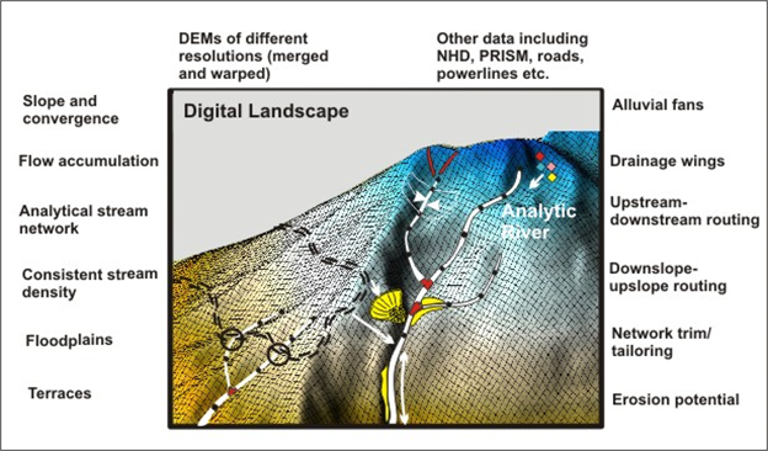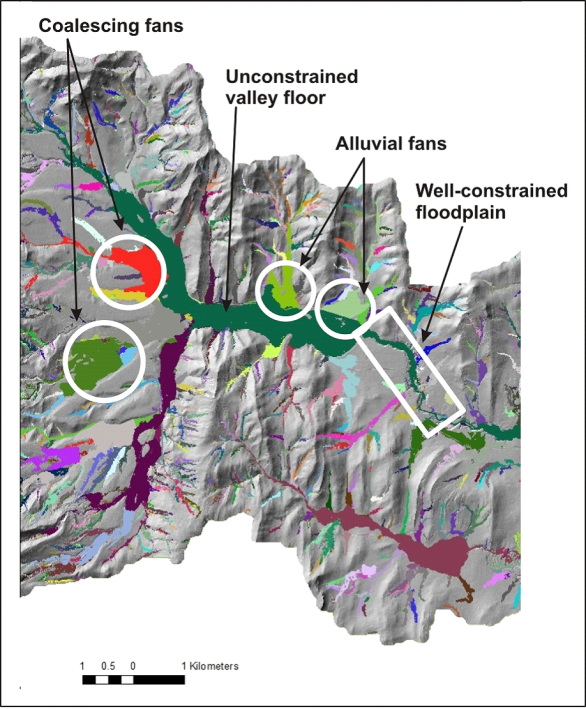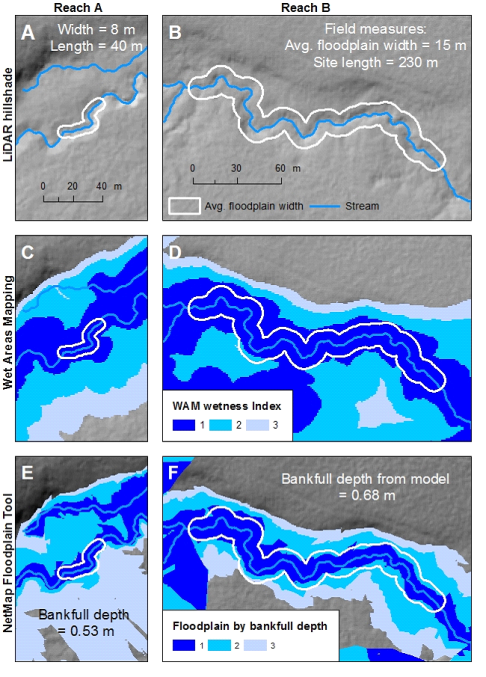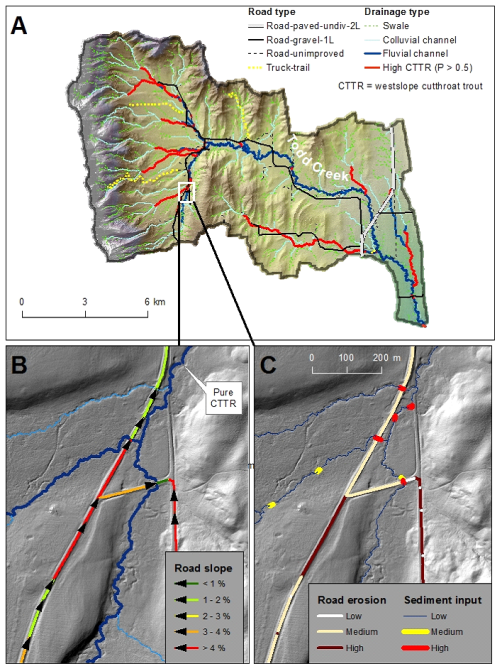NetMap's Digital Landscape
1.0 Digital Landscape
NetMap’s digital landscape is a geospatial data structure used within geographical information system (GIS) software (or web browsers) where all locations are referenced to all others, allowing landforms and ecological processes to be placed in spatial context with resource use activities and infrastructure. Landforms can include small streams, large rivers, floodplains, wetlands, and other topography including hillsides and alluvial fans. Physical processes can encompass climate in the form of storms, fires, floods, and climate change, and erosion and habitat forming processes. Human activities involve forestry, transportation, energy development (roads, drill pads, pipelines, open pit mines), agriculture, grazing, and urbanization, among others including river restoration and conservation.
NetMap consists of two major components: 1) a digital landscape and 2) decision support tools. These are used to provide decision support to a range of resource use activities including: forestry, grazing, fisheries, wildfire planning, climate change, watershed restoration, conservation and research.
Figure 1. NetMap’s "digital landscape" consists of a digital terrain model where all terrestrial and riverine surfaces are defined and topologically connected along physical process and biologically relevant pathways.
1.1 Digital Elevation Models
A digital elevation model (DEM) provides the base data structure of the digital landscape and creates virtual topography when used within a GIS or a web browser. A typical DEM uses a regular grid of cells circumscribing a specific geographic area with each cell corner represented by x, y and z coordinates. The spatial grain of the digital landscape is set by the resolution of the DEM, although larger cell sizes can be derived from finer-grain data. Various landforms can be delineated from the DEM, including river networks (often referred to as “stream layers” in GIS parlance), and other fluvial and terrestrial features (Tarboton 1991, Miller and Burnett 2008, Benda et al. 2011).
DEMs of varying resolutions can be derived directly from topographic maps. For example, the U.S. National Elevation Dataset (NED) consists of a 10m DEM rendered from 1:24,000-scale topographic maps (U.S.G.S. 2012). In the last decade, LiDAR (Light Detection and Ranging) technology has been used to map land surfaces to create high-resolution (sub 5m) DEMs. The province of Alberta has significant LiDAR coverage that has set the stage for effective use of desktop watershed analysis: NetMap employed 1m LiDAR in both the Hinton FMA and in the Oldman watershed.
DEMs are used to create shaded relief images, based on elevation, that provide realistic and attractive depictions of topography, including in three dimensions (e.g., Google Earth and similar mapping technologies) (Figure 1). Shaded relief and elevation maps are often used qualitatively in resource planning by providing spatial referencing of landforms such as steep hillsides, river channels and valley floors to locations of various land use activities.
1.2 Delineating River Networks and Landform Characterization
A river network, inferred from a DEM, is the fundamental landform of a digital landscape; it is referred to as an “analytic river” (Figure 2) to distinguish it from stream layers that are cartographic in origin (e.g., not derived directly from a DEM) and to denote its use in analytical applications involving watershed processes. Cartographic depictions of streams and rivers are digitized from topographic maps, yielding an important spatial catalogue of stream and river locations. Although they contain some attributes, such as stream segment length and stream name, they have limited utility in the context of environmental assessments and resource planning because they lack the analytic structure of the digital landscape (Figure 2), including attributes necessary to address resource use questions (Figure 1).
The analytic river is derived from surface flow paths inferred from a DEM (Figure 2). Various algorithms are available to predict flow direction in grid cells and to create a “flow direction grid” (Jenson and Domingue 1988, Tarboton 1997). Convergence of flow, under certain constraints, leads to channels; non-convergent flows represent the terrestrial landscape. Analytical rivers must encompass channels of all sizes, including the smallest headwater streams that are increasingly being recognized for their ecological importance (Richardson and Daheny 2007) but also their hazards (e.g., landslides and debris flows) (Burnett and Miller 2007). The analytic river network is divided into short segments for identifying variability in fluvial and valley environments, including channel morphology, aquatic habitats, floodplains and terraces. Channels are discretized where physical properties change abruptly, such as channel gradient and width, creating segment lengths of between 50m and 200m (Miller 2002). Characterizing variability in aquatic and riparian habitats could be used to tailor protection strategies based on specific environments, uniquely distributed in individual watersheds.
NetMap’s analytic river is attributed with channel and watershed information derived from the DEM and other digital data to facilitate resource use planning. Data include channel gradient, drainage area, mean annual flow, shear stress, stream order, distance from basin outlet, etc. (Table 1). Measures of flow discharge and hydraulic geometry (channel depth and width) are typically derived from regional regressions (Clarke et al 2008). Characterizing channel environments, such as bed substrate, channel types, and fish habitat quality, are included (Burnett et al. 2007, McCleary and Hassan 2008, Rich et al. 2003). Each river grid cell is referenced to all upstream and downstream river cells in a digital landscape. Upstream- downstream transfer of information, and vice-versa, supports analyses pertinent to fluvial processes such as sediment moving down river or fish moving up river.
Other landforms and their characterizations can be included in NetMap’s digital landscape. Floodplains, terraces, alluvial fans and combinations of hillslope gradient and planform curvature that reflect hillside susceptibility to gullying (Parker et al. 2007) and shallow landsliding (Miller and Burnett 2007) are added (Table 1). Tributary confluences are characterized for their potential to create morphological changes in channels and valley floors, including contributing to aquatic and riparian habitats (Benda et al. 2004) (Table 1). Widths of floodplains and valleys and their transitions from constrained to unconstrained (and vice versa) are included, attributes that have implications for aquatic habitats, flooding, and hyporheic flow (Benda et al. 2011). Closed depressions (e.g., drainage in, not out) combined with certain soil types (hydric) and landforms such as floodplains, are used to identify land surfaces in close proximity to water tables (e.g., wetlands or wet areas), a delineation relevant to ecological classification and forest site potential.
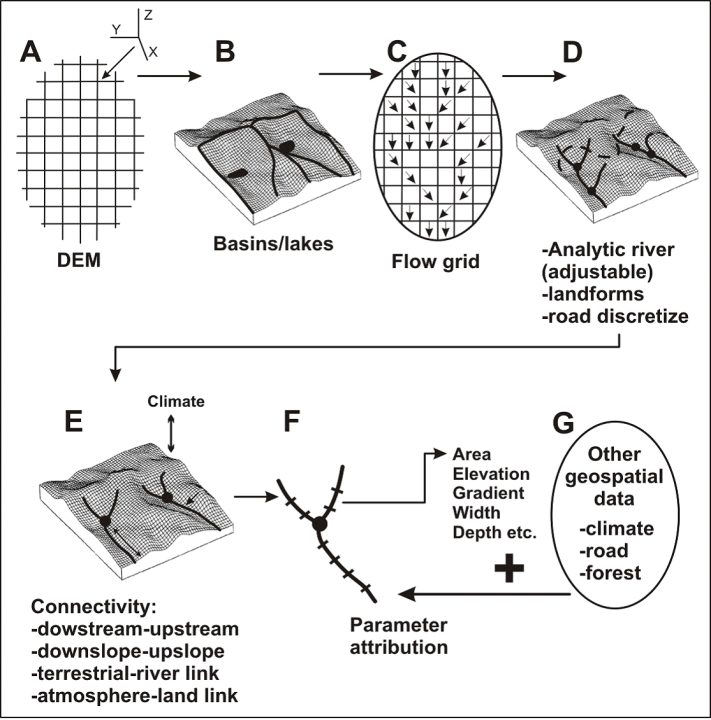
Figure 2. The digital landscape is comprised of a series of elements including (A) DEM, (B) basin and subbasin boundaries and lakes, (C) flow direction grid, (D) an analytic river with segments set by the spatial grain of the DEM, (E) information connections include drainage wings that allow for the downstream-upstream and downslope - upslope transfer of information, and (F) parameter attribution of stream segments (Table 1). Additional geospatial information can be integrated into the digital landscape to support various types of environmental assessments (G). The digital landscape can be coupled to a suite of watershed analysis tools.
Table 1. A wide range of physical and biological attributes (and their characterizations) can be associated with a digital landscape.
|
Channel Attributes
|
Landforms and Process Characterizations
|
|
· Gradient
· Shear stress
· Bed substrate
· Channel classification
· Fish habitats
· Channel width and depth
· Elevation
· Distance to outlet
· Radiation loading
|
· Floodplains
· Alluvial fans
· Tributary confluences
· Erosion potential
· Hillslope - gradient and convergence (mass wasting)
· Hillslope – slope profile
· (surface erosion)
· Valley width and transitions
· Debris flows
· Drainage density
|
1.3 River Network – Terrestrial Coupling
Just like real landscapes, terrestrial landforms are connected to river networks within a digital landscape by grid cell referencing. Downslope–upslope transfer of information, and vice-versa, addresses processes such as sediment moving from hillsides to rivers or animals transferring nutrients from streams and riparian zones to mid slope forests. Each river cell is linked to adjacent or nearby floodplain, terrace or valley cells, allowing riparian environments to be coupled to specific reaches of channel. For instance, riparian forests drive recruitment rates of in-stream wood and are directly related to formation of fish habitat (e.g., pools, cover), a relationship that ties spatial locations of valley floors and channels together.
Local drainage contributing areas (LCAs) are delineated on both sides of individual channel segments in a digital landscape (Figure 3); i.e., channels discretized between 50m and 200m create LCAs of tenths of a square kilometer in area. Terrestrial attributes at the LCA scale, such as lengths of roads and pipelines, vegetation type and age, erosion risk, etc., are summarized at that scale and are used to characterize those environments (Figure 3). Terrestrial information is transferred to channel segments as well, allowing hillslope information, including those representing resource uses and infrastructure (drilling pads, roads, forest harvest etc.), to be directly related to in-channel environments, including aquatic habitats. Data at the scale of LCAs and individual channel segments are aggregated downstream or upstream (often referred to as “routed” in a GIS), revealing patterns of terrestrial (or in-channel) attributes at any spatial scale defined by the river network.
Roads, railroads, energy pipelines and power transmission lines are discretized, breaking the data that represents them at pixel cell borders so that small sections of roads and pipelines (e.g., grid cell size) can be evaluated at the corresponding grid cell scale of the hillslope and analytic river. These linear features can be associated with similarly scaled indices of other landscape attributes such as erosion potential (Figure 3). Roads or pipelines that cross hillside grid cells are linked to channel cells via surface flow paths, thus providing a means to evaluate how roads and pipelines might affect fish habitats or water quality. Small road sections can be reaggregated to any scale, including that of LCAs, such as road drainage (or pipeline) diversion potential. Data at these multiple scales can be used to link hillslope erosion (surface, landslides, debris flows) to specific roads and pipelines and then to individual stream segments.
The spatial referencing of roads and pipelines, in combination with river routing of information in a digital landscape, can lead to innovative solutions to environmental needs, such as toxic spill response. For example, any location in a river network, such as municipal water intakes, can be characterized by a series of transport times and dilution rates from an upstream population of pipeline-stream crossings, or other energy development infrastructure in close proximity to water courses related to energy development.
NetMap’s data structure allows the cumulative distribution of any watershed or resource use attribute to be calculated on the fly at any scale. This structure allows terrestrial information (such as erosion potential) or road and pipeline density (km km-2) to be evaluated in terms of exceedence frequency or probability. Thus, a planner can quickly assess whether LCA’s with the highest 10% of erosion potential (due to roads) overlap with the top 10% of the most sensitive river channels. Identifying such locations could be used to prioritize areas where remedial efforts, such as road maintenance, would have the greatest benefit to freshwater ecosystems.
The geospatial data structure of a desktop watershed analysis should be customizable to individual watersheds and landscapes. Analytic river networks can be expanded or contracted, and segment lengths and LCAs can be decreased or increased in size, to meet the needs of particular applications. Thus the data structure (such as the analytic river) is not fixed in space and time, but rather it is dynamic, ensuring that analyses remain accurate and relevant. In addition, knowledge generated within an analytic stream layer (NetMap) can be transferred to other agency and private sector stream layers and vice versa.
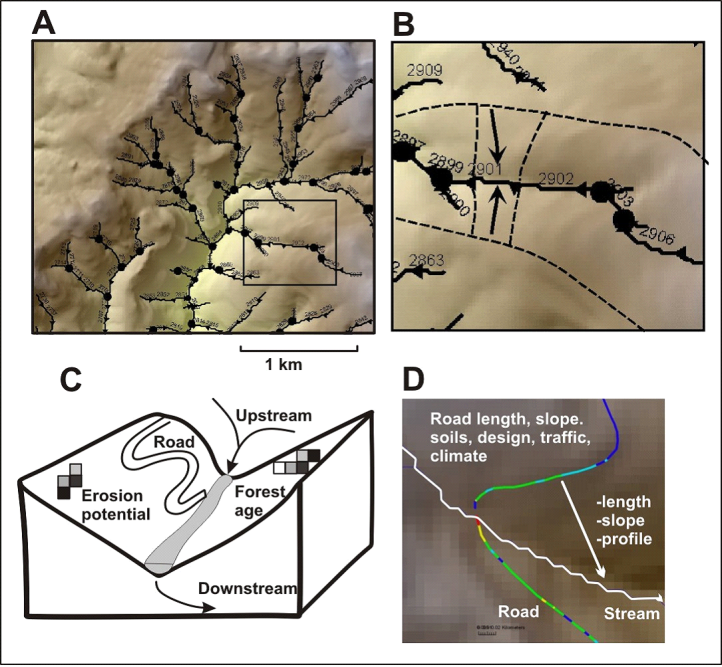
Figure 3. The digital landscape includes (A) a routed analytic river with confluences, including with attributes (Table 1). (B) Each segment has a right-left differentiated local contributing area or LCA (tenths of a square kilometer at segment length of 100m). (C) Information contained within LCAs, such as erosion potential, fire risk and road length, is transferred to stream segments. Information can also be aggregated downstream, revealing patterns of channel and hillslope characteristics at any spatial scale defined by the channel network. LCAs support spatial analyses including identifying overlaps between terrestrial and riverine environments, including human related stressors (such as erosion, wildfire, roads etc.). (D) Roads (pipelines and power transmission lines) are broken at pixel borders to link road segments to pixel scale information on factors such as landslide potential; road pixel segments can also be re-aggregated to predict factors such as road drainage diversion potential.
1.4 High Relief Versus Low Relief Topography
The flow routing algorithms that create flow direction grids and delineate channel networks require topography that has measurable energy gradients, driven by relief. The greater the relief and the greater that surface and subsurface flow are driven by topography, the more accurate the derived surface flow directions and hence the analytic river network. This straightforward relationship between topography and flow paths may not exist in areas of very low relief, combined with complicated subsurface geology, such as in the boreal forests of northern Alberta (Devito et al. 2005).
In areas of very low relief and where DEMs are insufficient to determine flow gradients in all locations, optical satellite imagery can be used to map locations of open water in channels, and connected wetlands and sloughs. Particularly in areas of limited forest coverage, optical satellite imagery can be used to differentiate between land and water based on optical contrast and intensity where local slope gradient is insufficient to derive the river network (Burnett et al. 2012). Flow algorithms in NetMap’s desktop analysis system use a water mask to create an analytic river. Flow directions are guided by the water mask using monotonically decreasing channel slopes based on landscape scale elevation gradients. Ray-tracing algorithms are used to follow a constant velocity wave front confined to the water mask polygons (Burnett et al. 2012).
Connecting channel-adjacent water bodies to the predicted channel network is yet another challenge in low relief topography. Mapping connectivity between derived channel networks and bodies of water such as sloughs, ponds, beaver dammed channels, and lakes could be done using algorithms that employ channel-water body proximity, as well as other indicators such as underlying geology or vegetation. The derivation of flow paths and channel networks in very low relief areas will depend on available geospatial data, including the resolution of the DEM, and available satellite imagery.
2.0 Coupling the Digital Landscape to Decision Support Tools
A digital landscape can provide decision support when it is coupled to a set of analysis tools. NetMap's decision support system contains approximately 70 analysis tools that work with digital landscapes (and analytic rivers) to address numerous resource use questions (Benda et al. 2007, 2011; McCleary et al. 2011; Ferandez et al. 2012; Pickard 2013; Reeves et al. 2013).
· Where are streams and rivers located, including headwaters and what are their attributes?
· Where are floodplains, terraces, and alluvial fans located and which ones present the most risk to development?
· Where are the top 10% of the best aquatic habitats located in a watershed and where do they intersect the largest stressors from forestry or energy development?
· Which road segments or pipelines present the greatest 10% of risk to water quality and aquatic habitats?
· What segments of roads or transmission lines are most at risk from slope instability?
· Where does resource development overlap with the top 1% of mass wasting potential?
NetMap’s analysis tools are designed to work within 2013 ArcGIS software, presently ArcMap 10.x. Add-in modules include: 1) Basic Tools, 2) Fluvial Morphology, 3) Aquatic Habitats, 4) Erosion, 5) Transportation/Energy, and 6) Riparian Management.
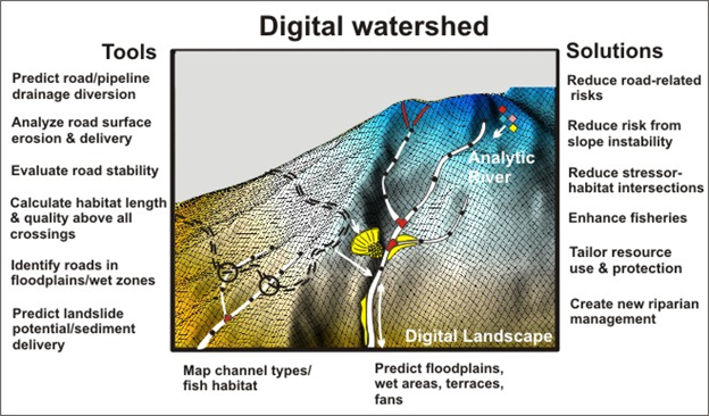
The Basic Tools encompass various data query and management functions and includes stream and hillslope profiling, routing of attributes downstream or upstream, Google Earth interface, risk analysis, and subbasin classification functions. Fluvial Morphology contains 23 tools and parameters that provide a wealth of channel physical attributes (see Table 1); network attributes (stream order, confluence types, drainage density, etc.); several channel and fish habitat classification methods; floodplain, terrace and alluvial fan mapping; and in-stream wood accumulation. The Aquatic Habitat module contains 13 tools for predicting fish habitat (resident and anadromous), beaver habitat, core habitat areas, habitat diversity, and cumulative habitat length and quality along the channel among others. The Erosion module includes interfaces for shallow failure, gully formation, debris flow, earthflows, surface erosion, sediment yield, and sediment delivery.
The Transportation/Energy module contains tools for addressing road or pipeline density at multiple scales (stream reach, river network, and subbasins), road stability, roads in floodplains, habitat length and quality upstream of all road (or pipeline) crossings, road surface erosion, and sediment delivery to streams. The Transportation/Energy tools could be used retrospectively to identify provisional habitat-stressor hotspots across large geographic areas (FMAs or energy leases) or used prospectively to identify the least at-risk locations for future roads, pipelines, or energy transmission lines.
The Riparian Management module contains interfaces for radiation loading, in-stream wood recruitment (stream reach and watershed scale), upslope (mass wasting) wood recruitment, and vegetation simulation. This tool suite can be used to tailor riparian and stream protection strategies across diverse landscapes rather than relying on uniform, one-size-fits-all prescriptions (Pickard 2013, Reeves 2013).
All models contained within the modular add-ins are based on the published literature (for additional information, refer to www.netmaptools.org). All tools are supported by 600 pages of online hyperlinked technical help materials that cover tool use, scientific background, example applications, and related reference materials. A critical and necessary element in NetMap’s desktop watershed system is that all tools work seamlessly with one another to support multi- and interdisciplinary analyses within the uniform data structure of the digital landscape.
3.0 Illustrative Applications in Alberta
3.1 West Fraser Forest Management Agreement (FMA)
Forest products companies in Alberta, including West Fraser Timber Company Ltd., are under increasing pressure to ensure that timber harvesting and reforestation practices are consistent with non-timber values, such as protecting freshwater ecosystems. Classifying channel types (e.g., ephemeral, intermittent, and permanent) and mapping habitat extent for headwater dwelling fishes (e.g., bull trout [Salvelinus confluentus] and rainbow trout [O. mykiss]) are necessary to effectively apply the regulatory protocols for forest harvesting and road construction that can impact aquatic resources in Alberta (ASRD 2008). Streamside buffers are retained to provide travel corridors for animals and to reduce risk to aquatic resources, and they have been traditionally based on the width of the adjacent channel. An accurate stream layer, inclusive of headwaters, with associated physical attributes that can be used for channel classification and fish habitat modeling, is required to accomplish this.
Alberta maintains a digital (cartographic) stream layer (derived from 1: 20,000-scale topography) that includes a single-line network (AENV 2000). Rivers larger than 20 m in width are well represented, but smaller watercourses are less accurately depicted. For example, channels less than 5 m in width are often classed as “indefinite” because they are poorly distinguished (McCleary and Hassan 2008). Many streams less than 1.5 m wide are obscured beneath vegetation and are not included in the cartographic stream layer (McCleary 2011) (Figure 4A). The inadequately represented headwater streams, which comprise more than 60% of the total length of the river network in the Rocky Mountain Foothills region (McCleary 2011), are ecologically important and require regulatory protection (ASRD 2008). Alberta also has a stream layer (derived from 1 m DEMs) that accurately identifies the majority of the channel network (Figure 4C) and includes probable locations of land surfaces that are in close proximity to water tables (“wet areas”) (White et al. 2012). The wet areas network contains long segment lengths (kilometers), lacks physical attributes, is not routed, and is not coupled to the DEM (e.g., there is an absence of downslope, upslope routing). Therefore, this network is limited regarding its use in more comprehensive desktop watershed analyses (see Figures 1 and 2).
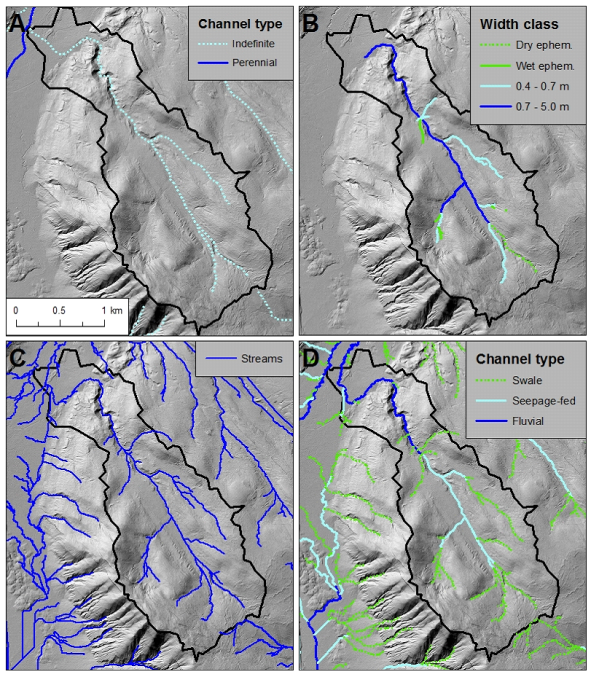
Figure 4. Maps of Athabasca Tower watershed, Alberta, from four sources with various types of segment attributes including: (A) the Alberta provincial stream network with a feature type classification, (B) actual stream channels as determined from GPS field surveys with a width-based classification scheme; (C) an unattributed LiDAR derived network (Alberta wet area map, White et al. 2012); and (D) an attributed LiDAR-derived network created by NetMap with an erosion-based classification displayed.
Hinton Wood Products (HWP), a Division of West Fraser Mills Ltd., in conjunction with the Foothills Research Institute and Earth Systems Institute, applied NetMap using 1-meter DEMs to support channel and fish habitat classification within a digital landscape (10,000 km2) (McCleary 2011). GPS-based field surveys were used to calibrate and validate NetMap’s analytic network (Figure 4B). Channel attributes in the analytic river required for classifying channels and habitats include drainage area, channel gradient, mean basin slope, floodplains and longitudinal profiles (McCleary 2011). The resulting characterization of channel types (uplands, swales, seepage-fed channels, fluvial channels, and floodplains) and fish habitats allows HWP to incorporate them in forest management planning, including in designing riparian protection zones (Figure 4D). NetMap’s floodplain mapping will be used to map riparian zones at a range of elevations above the channel (to match field observations). This data can be used to consider how floodplain and low terrace extent and elevation relate to channel environments and proximity to water table.
Another need in the Hinton Wood Products FMA is to identify landforms with a high susceptibility to erosion and sediment delivery to stream channels. One of NetMap’s indices of erosion susceptibility is based on slope steepness and planform curvature (Miller and Burnett 2007), attributes well recognized in controlling the potential for shallow landsliding and gullying (Dietrich and Dunne 1978, Sidle 1987). The analysis revealed great spatial variability in hillside erosion susceptibility across the FMA. For example, within the Athabasca Tower Research Watershed, erosion potential is high at only two locations–along the inner gorge of the outlet stream draining a hanging valley and at the southwest flank of the basin (Figure 5). The predicted erosion potential, when combined with channel classification, is used to evaluate risk to aquatic biota and water quality. For instance, sediment delivery to the fluvial channel network would present a sedimentation and water quality risk while sediment delivery to the unchannelized portion (upper southwest flank) would not pose any risk (Figure 5). Such erosion maps can be used to evaluate existing and future locations of forest management activities, specifically those related to road construction.
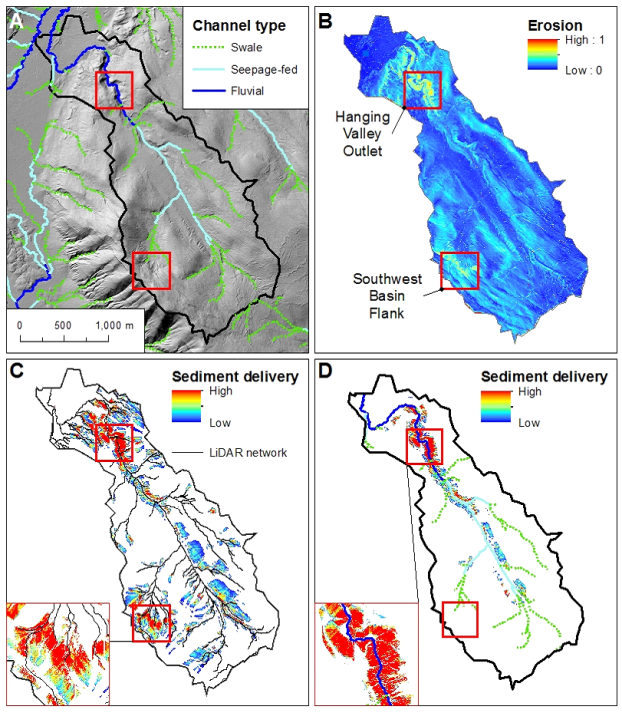
Figure 5. Athabasca Tower Research Watershed with (A) channel classification assigned to the NetMap LiDAR-derived network, (B) erosion potential with windows highlighting two locations with predicted high erosion, (C) predicted sediment delivery to the entire LiDAR-derived network, and (D) sediment delivery potential to channels (e.g., fluvial
3.2 Oldman River Basin
The Alberta Provincial Government, in conjunction with Earth Systems Institute and the Foothills Research Institute, evaluated the use of desktop watershed analysis technology (NetMap) for assessing cumulative watershed effects (CWE) in the Oldman River basin (McCleary 2013). An analysis of CWE contains three steps: 1) characterize relevant watershed landforms and processes, 2) estimate how land use and infrastructures affect them, and 3) determine whether altered landscape processes impact important resources and whether mitigation is warranted (WDNR 2011).
There are a several potential stressors in the Oldman watershed (3,000 km2) including grazing, forestry, residential development, and energy pipelines. NetMap’s desktop analysis was used to: 1) create a digital landscape, including an accurate and attributed analytic stream network, 2) predict fish habitat, 3) map floodplains and terraces at various elevations above the channel, and 4) predict road (and ATV trail) drainage connectivity, surface erosion, and sediment delivery to streams (McCleary 2013). Although NetMap contains numerous other attributes and tools, these four were chosen for the demonstration analysis.
NetMap’s desktop analysis produced an analytic stream layer that included a liberal channel density with the objective being to include all streams, particularly headwaters (Figure 6). The “channel trim” tool in NetMap can be used to reduce the density of the analytic river by selectively removing headwaters so that the network can be tailored to actual field conditions. The channel classification scheme developed for the Hinton Wood Products FMA (McCleary et al. 2011) was applied; categories included swale, colluvial channels, and fluvial channels (Figure 6). NetMap’s landform mapping tool delineated floodplains, unconstrained valley floors (e.g., wide floodplains and zones of channel sedimentation), terraces, and alluvial fans (Figure 7). The elevation above the channel (in multiples of bankfull depth) and the lateral search radius were adjusted to match local controls on floodplain extent (Figure 8). For example, the floodplain predicted by one and two multiples of flow depth accurately identified the floodplain extent mapped in the field. Individual and coalescing alluvial fans represent zones where sedimentation and flooding can pose risks to land development. In addition, wide and narrow floodplains are ecologically important and have certain regulatory protections associated with them (Province of Alberta 2012).
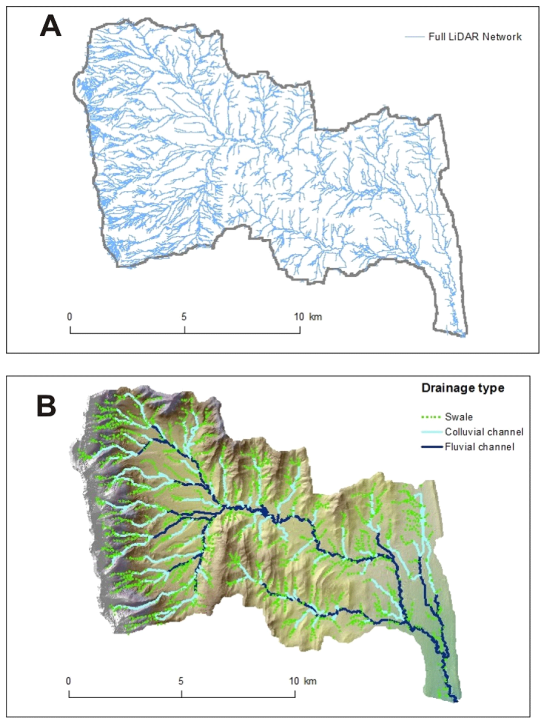
Figure 6. (A) NetMap’s liberal density analytic river network in the Oldman River basin. Excess stream segments (headwaters) can be removed using a trim tool with the network subsequently reorganized to support downstream-upstream routing of information. (B) The channel classification of McCleary et al. (2011) was applied across the Oldman River basin.
Figure 7. NetMap’s flexible landform mapping tool is used in the Oldman River basin to identify alluvial fans, coalescing fans, and constrained and unconstrained valley floodplains. These landforms can be used to identify provisional areas of high risk to land use. The different colors correspond to different elevations above channels and different search radii that were used.
Figure 8. Terrain features (A and B) including the field delineated 50-year floodplain for two Todd Creek reaches linked to NetMap’s LiDAR-derived analytic river. The area indicated as floodplain was inundated during flood stage equivalent to two bankfull depths. The terrain features are linked to UNB’s wet areas map (C and D). Using NetMap’s flexible landform mapping tool, the terrain features are linked to predicted floodplains (E and F).
Effects of stressors on fish habitat are an important consideration in the Oldman basin. The distribution of westslope cutthroat trout spawning and rearing habitat was predicted in the Todd Creek basin, a tributary of the Oldman River (Peterson et al. 2008) (Figure 9). Model parameters include reach gradient, stream temperature (or a surrogate constant), and wetted stream width. Using NetMap, road drainage and road surface erosion models were used to predict sediment production to streams from all roads (and trails) in the watershed. Required model variables include road (or trail) hydrologic connected length (flow along the road to drain points or stream channels), road gradient, width, surface type, traffic level (high to low), design (inslope, outslope), soil type, and hillslope distance and gradient to the nearest stream (Flannigan and Livingston 1995). Only a small proportion of the road network was predicted to deliver significant road surface sediment to stream channels (Figure 10).
7
Figure 10. (A) The Oldman watershed contains a diversity of types of roads and trails. Road drainage and road surface erosion tools were used to estimate potential sediment delivery into streams and high quality fish habitat, including in Todd Creek subbasin (lower Todd Creek indicated in white box). (B) Road gradient, a major driver of surface erosion potential, is shown for a portion of a gravel road that sits close to high quality fish habitat. Arrows denote direction of road runoff. (C) Road surface erosion and sediment inputs to channels are indicated. High erosion potential is predicted to occur along several sections of the main gravel road, intersecting areas of high quality fish habitat (see Figure 9).
The main one-lane gravel road is of special concern due to its multiple crossings over high value westslope cutthroat trout habitat, relatively high traffic levels, and regular road maintenance. The road follows the mainstream of Todd Creek and presents a potential risk to high value fisheries (Figure 10). Forest roads can drain directly into streams and they may have other drain points into forested hillslopes. NetMap calculates the length of hydrologically connected road segments using topography (DEM). Small road segment lengths allowed close examination of road gradients, their proximity to streams, and predicted road surface erosion. Predicted road erosion was ranked low, medium, or high for individual segments, including referencing sediment delivery to streams (Figure 10D). Only a few road segments of the busiest gravel road presented a sedimentation risk to high value habitat. Once validated, the predictions could be used to design and implement sediment reduction activities at specific locations (i.e., those areas that would yield the greatest benefit to fisheries).
4.0 Conclusions
Building digital watersheds at the scale of landscapes, regions, and provinces has the potential to advance how resource use is planned and implemented in the context of physical and biological attributes of landscapes, including in Alberta, Canada. It can significantly reduce stressor-habitat interactions and promote more sustainable land use in Alberta and beyond, making resource use more defensible, while restraining costs of environmental assessments. Building a digital watershed using a consistent data structure within a GIS or in online browsers has the potential to serve as a communication medium to connect science and technology developers with the large number of information consumers.
NetMap’s use of digital watersheds and tools as illustrated in the Hinton Wood Products FMA and the Oldman watersheds can range in level of effort. An initial analysis includes streams and rivers (the analytic river) with numerous attributes (Table 1), channel response types, aquatic (fish) habitat quality and distribution, erosion source areas, sediment delivery, environmental stressors related to roads and pipelines, and riparian environments. This level of information will allow experts and generalists (e.g., resource managers and planners) alike to predict locations where land use stressors intersect sensitive habitats with a high degree of specificity. For example, a planner will be able to identify provisional hotspots where the top 5% of the highest road surface erosion overlaps the top 5% of fish habitat quality or where the highest 10% of hillslope erosion potential is located in a watershed. Field validation of predicted attributes should be a component of desktop analyses; the inclusion of field data and other field measurements is recommended to make desktop analysis more robust.
A more detailed analysis could involve 1) creating spill response maps using the routing capabilities in NetMap, 2) coupling wildfire risk to erosion potential (surface and mass wasting), 3) supporting a watershed scale sediment budget or 4) assessing riparian management in the context of in-stream wood recruitment and thermal loading. Assessing the role of vegetation removal on slope stability (landslides and debris flows) could be included, as well as the role of climate change on altering flow regimes and impacting fish habitat. This level of analysis might also require that detailed field surveys be performed in which models are calibrated with local data.
References
Benda L, Poff NL, Miller D, Dunne T, Reeves GH, Pess GH, Polluck M. 2004. The network dynamics hypothesis: How channel networks structure riverine habitats. Bioscience 54: 413–427.
Benda, L., D. J. Miller, K. Andras, P. Bigelow, G. Reeves, and D. Michael. 2007. NetMap: A new tool in support of watershed science and resource management. Forest Science 52:206-219.
Benda, L., D. Miller, S. Lanigan, and G. Reeves. 2009. Future of applied watershed science at regional scales. EOS, Transaction American Geophysical Union 90:156-157.
Benda, L., Miller, D., and Barquín, J. 2011. Creating a catchment scale perspective for river restoration, Hydrol. Earth Syst. Sci., 15, 2995-3015, doi:10.5194/hess-15-2995-2011.
Burnett, K. M., et al. 2007. Distribution of salmon-habitat potential relative to landscape characteristics and implications for conservation. Ecological Applications 17(1): 66-80.
Burnett, K. M., D. J. M., Rick Guritz, Mark A. Meleason, Ken Vance-Borland, Rebecca Flitcroft, Matthew J. Nemeth, Justin Priest, Nicholas A. Som, Christian E. Zimmerman. 2013. 2011 Arctic-Yukon-Kuskowkwin Sustainable Salmon Initiative. Project Final Report: 79.
Clarke, S.E., Burnett, K.M., and Miller, D.J. 2008. Modeling streams and hydrogeomorphic attributes in Oregon from digital and field data. Journal of the American Water Resources Association 44(2): 459-477.
Collins, B. D. and G. R. Pess. 1997. Critique of Washington's Watershed Analysis Programs (Bigelow). Journal of American Water Resources Association 33(5): 997-1010.
Creed, I.F., Sass, G.Z., Wolniewicz, M.B., and Devito, K.J. 2008. Incorporating hydrologic dynamics into buffer strip design on the sub-humid Boreal Plain of Alberta. Forest Ecology and Management 256(11): 1984-1994.
Dietrich, W. E. and T. Dunne. 1978. Sediment budget for a small catchment mountainous terrain. Zietshrift fur Geomorphologie: 191-206.
Devito, K., Creed, I., Gan, T., Mendoza, C., Petrone, R., Silins, U., and Smerdon, B. 2005. A framework for broad-scale classification of hydrologic response units on the Boreal Plain: is topography the last thing to consider? Hydrological Processes 19(8): 1705-1714. <Go to ISI>://000229232800010.
Everest, F. H., and G. H. Reeves. 2007. Riparian and aquatic habitats of the Pacific Northwest and Southeast Alaska: Ecology, Management History and Potential Management Strategies. Gen.Tech. Rep. PNW-GTR-692 Pacific Northwest Research Station.
Fernandez, D., J. Barquin, M. Alvarez-Cabria, and F.J. Penas. 2012. Quantifying the performance of automated GIS-based geomorphological approaches for riparian zone delineation using digital elevation models. Hydrol. Earth Syst. Sci., 16, 3851–3862, www.hydrol-earth-syst-sci.net/16/3851/2012/.
Flanagan, D. C., and S. J. Livingston. 1995. WEPP User Summary: USDA–Water Erosion Prediction Project (WEPP). NSERL Report No. 11. W. Lafayette, Ind.: USDA–ARS National Soil Erosion Research Laboratory.
Foote, L. 2012. Threshold considerations and wetland reclamation in Alberta’s Mineable Oil Sands. Ecology and Society V. 17, No. 1: 35pp
Gosselin, P., S. Hrudey, A. Naeth, A Plourde, R. Therrien, G. Van Der Kraak, and Z. Xu. 2010. Environmental and health impacts of Canada’s Oils Sands Industry. The Royal Society of Canada (Expert Panel). 22pp.
Gucinski, H. H., H. B., M. J. Furniss, R. R. Ziemer . 2001. Forest roads: a synthesis of scientific information. U.S. Department of Agriculture, Forest Service, General Technical Report PNW-GRT-509, Portland Oregon: 103.
Gregory, S. V., et al., Eds. 2003. The Ecology and Management of Wood in World Rivers. Bethesda, Maryland, American Fisheries Society.
Hassan, M. A., M. Church, T.E. Lisle, F. Brardinoni, L. Benda, G.E. Grant. 2005. Sediment transport and channel morphology in small forested streams. Journal of the American Water Resources Association 41(4): 853-876.
Jenson SK and Domingue JO, 1988. Software tools to extract topographic structure from digital
elevation data for geographic inform
McCleary, R.J., and Hassan, M.A. 2008. Predictive modeling and spatial mapping of fish distributions in small streams of the Canadian Rocky Mountain foothills. Canadian Journal of Fisheries and Aquatic Sciences 65: 319-333.
McCleary, R.J. 2011. Landscape organization based on application of the process domain concept for a glaciated foothills region. PhD thesis. University of British Columbia. Vancouver, B.C. https://circle.ubc.ca/bitstream/handle/2429/32154/ubc_2011_spring_mccleary_richard.pdf?sequence=1 (Accessed June 14, 2012).
McCleary, R. J., M.A. Hassan, D. Miller and R.D. Moore. 2011 Spatial organization of process domains in headwater drainage basins of a glaciated foothills region with complex longitudinal profiles. Water Resources Research, Vol. 47. Pp17.
McCleary, R.J. 2013. A cumulative watershed effects assessment template for the Eastern Slopes: the geomorphic and riparian components with a case study of Todd Creek. Report completed for the Foothills Research Institute.
Miller, D. 2002. Program for DEM analysis, in Landscape Dynamics and Forest Management. Gen. Tech. Rep. RMRS-GTR-101CD, U.S.D.A. Forest Service, Rocky Mountain Research Station, Fort Collins, CD-ROM.
Miller, D. J., and K. M. Burnett, 2007. Effects of forest cover, topography, and sampling extent on the measured density of shallow, translational landslides, Water Resources. Res., 43, W03433, doi:10.1029/2005WR004807.
Montgomery, D. R., et al. 1995. Watershed Analysis as a Framework for Implementing Ecosystem Management. Water Resources Bulletin 31(3): 369-386.
Naiman, R. J. and R. E. Bilby. 1998. River Ecology and Management in the Pacific Coastal Ecoregion. River Ecology and Management: Lessons From the Pacific Coastal Ecoregion. New York, Springer-Verlag. Chapter 1: 1-9.
National Park Service (NPS). 2005. Elwha River ecosystem restoration implementation. Final Environmental Impact Statement. National Park Service. 336pp.
Oregon Watershed Enhancement Board (OWEB). 1999. Oregon Watershed Assessment Manual.
Parker, C., C. Thorne, R. Bingner, R. Wells, D. Wilcox. (2007. Automated Mapping of Potential for Ephemeral Gully Formation in Agricultural Watersheds. National Sedimentation Laboratory, Publication No. 56.
Peterson, D. P. B. E. R., J. B. Dunham, K. D. Fausch, M. K. Young, Michael. 2008. Analysis of trade-offs between threats of invasion by nonnative brook trout (Salvelinus fontinalis) and intentional isolation for native westslope cutthroat trout (Oncorhynchus clarkii lewisi). Canadian Journal of Fisheries and Aquatic Science 65: 557-573.
Pickard, B.R. 2013. Keying forest stream protection to aquatic ecosystem values in multi-ownership watersheds. MSc. Thesis, Oregon State University, Corvallis, OR. 150 p.
Province of Alberta. 2012. Water Act. http://www.qp.alberta.ca/1266.cfm?page=w03.cfm&leg_type=Acts&isbncln=9780779733651 (Accessed April 18, 2013).
Reeves, G.H., L.E. Benda, K.M. Burnett, P.A. Bisson, and J.R. Sedell. 1995. A disturbance-based ecosystem approach to maintaining and restoring freshwater habitats of evolutionarily significant units of anadromous salmonids in the Pacific Northwest. American Fisheries Society Symposium 17: 334-349.
Reeves, G.H., B.R. Pickard, and K.N. Johnson. 2013. Alternative Riparian Buffer Strategies for Matrix Lands of BLM Western Oregon Forests That Maintain Aquatic Ecosystem Values.
Reid, L. M. and B. P. McCammon. 1993. A procedure for watershed analysis. Review draft prepared for the Interagency Forest Ecosystem Management Assessment Team. 139.
Reid, L. M. and T. Dunne. 1996. Rapid Construction of Sediment Budgets for Drainage Basins. Cremlingen, Germany, Catena-Verlag.
Reid, L. 1998. Cumulative watershed effects and watershed analysis. Pacific Coastal Ecoregion. R. Naiman and R. Bilby: 476-501.
Rich, C., T. McMahon, B. Rieman, and W. Thompson. 2003. Influence of local habitat, watershed, and biotic features on bull trout occurrence in Montana streams. Transactions of the American Fisheries Society 132:1053–1064.
Richardson, J. and R. Danehy. 2007. A Synthesis of the Ecology of Headwater Streams and their Riparian Zones in Temperate Forests. Forest Science 53(2):131–147.
Richardson, J. S., R. J. Naiman, P. A. Bisson. 2012. How did fixed-width buffers become standard practice for protecting freshwaters and their riparian areas from forest harvest practices. Freshwater Science 31(1): 232-238.
Sidle, R. C. 1987. A dynamic model of slope stability in zero-order basins. IAHS Publ. 165: 101-110.
Tarboton, D. G., R.L. Bras, and I. Rodriguez-Iturbe. 1991. On the extraction of channel networks from digital elevation data. Hydrological Processes 5: 81-100.
Tarboton, D.G. 1997. A new method for the determination of flow directions and upslope areas in grid digital elevation models, Water Resources Research, 33 (2), 309-319.
Washington Department of Natural Resources (WDNR). 1992, 2011. Forest Practices Board Manual, Section 11: Methodology for conducting watershed analysis. http://www.dnr.wa.gov/publications/fp_wsa_manual_part_1_8.pdf (Accessed Feb. 18, 2013).
White, B., J. Ogilvie, D. Campbell, D. Hiltz, B. Gauthier, H. Chisholm, J. Wen, P. Murphy, and P. Arp. 2012. Using the cartographic depth-to-water index to locate small streams and associated wet areas across landscapes. Canadian Water Resources Journal 37(4): 333-347.

